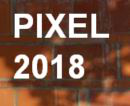Speaker
Description
CMOS sensors with a small collection electrode are attractive for a wide range of applications due to the very low sensor capacitance allowing for a very low noise and analogue power consumption. Such sensors have been studied and developed for the ALICE ITS upgrade, where they have been selected as the technology of choice. To achieve a full lateral depletion in the sensor, a process modification has been performed, making this technology also attractive for detectors in harsh radiation environments, such as for the ATLAS ITk upgrade, and for detectors with time resolution requirements in the order of a few nanoseconds, such as the CLIC tracking system. However, the electric field in the sensor reaches a minimum in the pixel corners, more pronounced for larger pixel sizes, increasing the charge-collection time. This can result in a degraded timing resolution and loss of efficiency after irradiation. Recent studies of this technology have shown the challenge to achieve a fully efficient operation after irradiation and a timing resolution in the order of a few nanoseconds precision for pixel sizes of larger than approximately 40 micrometres. This paper presents three-dimensional self-consistent Technology Computer Aided Design Simulations for two concepts to improve the timing resolution and radiation hardness for a given pixel size: a mask change and an additional implant. The transient simulation has been performed for several variations of the proposed designs and of the operation conditions for non-irradiated and irradiated sensors. The simulation results indicate a significant improvement of the charge-collection time before and after irradiation and of the collected charge after irradiation. The new designs are now implemented in a next submission of the ATLAS prototype chips in this technology.




